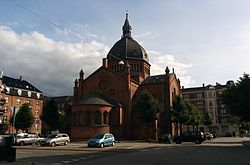

| St. Mark's Church | |
|---|---|
| Sankt Markus Kirke | |

St. Mark's Church seen from Julius Thomsens Plads
| |
 | |
| 55°40′47.6″N 12°33′9.5″E / 55.679889°N 12.552639°E / 55.679889; 12.552639 | |
| Location | Frederiksberg, Copenhagen |
| Country | Denmark |
| Denomination | Church of Denmark |
| History | |
| Status | Church |
| Architecture | |
| Architect(s) | Carl Lendorf |
| Architectural type | Church |
| Groundbreaking | 1900 |
| Completed | 1902 |
| Specifications | |
| Materials | Brick |
| Administration | |
| Archdiocese | Diocese of Copenhagen |
St. Mark's Church (Danish: Sankt Markus Kirke) is a church at the end of Julius Thomsens Plads in the Frederiksberg district of Copenhagen, Denmark.

The church was built from 1900 to 1902 to the design of Carl Lendorf. It was consecrated on 9 November 1902 at a ceremony attended by Bishop Kultus Minister J. C. Christensen.
The area was still quite undeveloped on its completion but the surrounding buildings were built from 1903 to 1904 according to a symmetrical plan by Andreas Clemmensen.[1]
The church is a cruciform church built in red brick with inspiration from Byzantine and Romanesque architecture.
Over the main portal there is a mosaic by Oscar Willerup depicting Saint Mark the Evangelist with a quill and a winged lion, his symbol.[2]
The church is used as a location in the 2003 comedy Se til venstre, der er en svensker.[3]
|
Frederiksberg (Copenhagen area)
| |
|---|---|
| Localities |
|
| Streets and squares |
|
| Parks and open spaces |
|
| Culture and attractions |
|
| Education |
|
| Churches |
|
| Other landmarks |
|
| Railway and metro stations |
|
| History |
|
|
Churches in Copenhagen, Denmark
| |
|---|---|
| City Centre |
|
| Amager |
|
| Bispebjerg |
|
| Brønshøj-Husum |
|
| Frederiksberg |
|
| Nørrebro |
|
| Valby |
|
| Vesterbro/Kgs. Enghave |
|
| Østerbro |
|
| Surroundings |
|